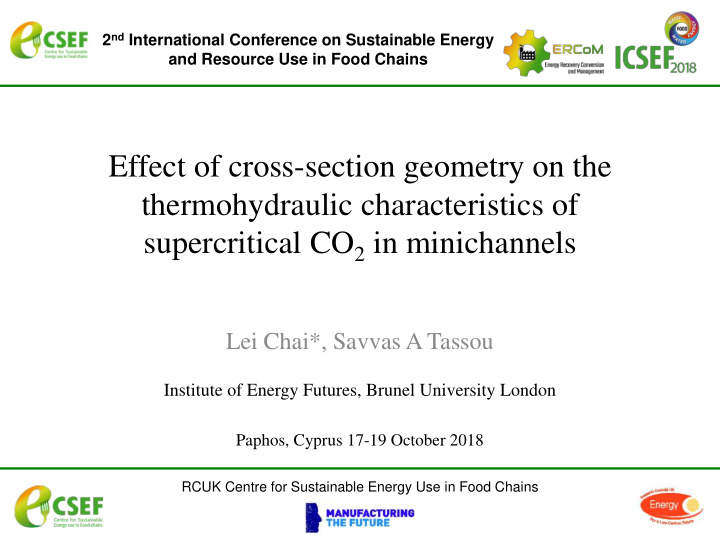



2 nd International Conference on Sustainable Energy and Resource Use in Food Chains Effect of cross-section geometry on the thermohydraulic characteristics of supercritical CO 2 in minichannels Lei Chai*, Savvas A Tassou Institute of Energy Futures, Brunel University London Paphos, Cyprus 17-19 October 2018 RCUK Centre for Sustainable Energy Use in Food Chains
2 nd International Conference on Sustainable Energy and Resource Use in Food Chains Outline • Introduction – Why sCO 2 ? Why minichannels? • Computational method – Element, model, boundary condition. • Data acquisition – Local and average parameters. • Results and discussion – Thermohydraulic performance, comparison with correlations. • Future work RCUK Centre for Sustainable Energy Use in Food Chains Lei Chai 2
2 nd International Conference on Sustainable Energy and Resource Use in Food Chains Why sCO 2 ? • Environment-friendly, nontoxic, non- flammable • a zero net impact on climate change • reduced emission of greenhouse gas • high power density for power generation • transcritical refrigeration cycle • supercritical Brayton cycle • natural circulation loops RCUK Centre for Sustainable Energy Use in Food Chains Lei Chai 3
2 nd International Conference on Sustainable Energy and Resource Use in Food Chains Why minichannels? • highly compact construction • high heat transfer coefficient • high pressure capability • lower fluid inventory Cross-section geometry exerts an influence on fluid flow and heat transfer RCUK Centre for Sustainable Energy Use in Food Chains Lei Chai 4
2 nd International Conference on Sustainable Energy and Resource Use in Food Chains Computational element and model • standard k- ε model • NIST real gas thermophysical properties • buoyant effect RCUK Centre for Sustainable Energy Use in Food Chains Lei Chai 5
2 nd International Conference on Sustainable Energy and Resource Use in Food Chains Why NIST real gas model? RCUK Centre for Sustainable Energy Use in Food Chains Lei Chai 6
2 nd International Conference on Sustainable Energy and Resource Use in Food Chains Boundary and operating conditions • Constant heat flux for channel wall, velocity-inlet for channel inlet, pressure-outlet for channel outlet • Corresponding mass flux for the four cases are 545.6, 1629.5, 473.9 and 561.3 kg/(m 2 ·s) RCUK Centre for Sustainable Energy Use in Food Chains Lei Chai 7
2 nd International Conference on Sustainable Energy and Resource Use in Food Chains Data acquisition RCUK Centre for Sustainable Energy Use in Food Chains Lei Chai 8
2 nd International Conference on Sustainable Energy and Resource Use in Food Chains Local fluid temperature RCUK Centre for Sustainable Energy Use in Food Chains Lei Chai 9
2 nd International Conference on Sustainable Energy and Resource Use in Food Chains Local heat transfer coefficient RCUK Centre for Sustainable Energy Use in Food Chains Lei Chai 10
2 nd International Conference on Sustainable Energy and Resource Use in Food Chains Local Nusselt number RCUK Centre for Sustainable Energy Use in Food Chains Lei Chai 11
2 nd International Conference on Sustainable Energy and Resource Use in Food Chains Local pressure drop RCUK Centre for Sustainable Energy Use in Food Chains Lei Chai 12
2 nd International Conference on Sustainable Energy and Resource Use in Food Chains Local friction factor RCUK Centre for Sustainable Energy Use in Food Chains Lei Chai 13
2 nd International Conference on Sustainable Energy and Resource Use in Food Chains Average thermohydraulic performance RCUK Centre for Sustainable Energy Use in Food Chains Lei Chai 14
2 nd International Conference on Sustainable Energy and Resource Use in Food Chains Comparison with heat transfer correlations RCUK Centre for Sustainable Energy Use in Food Chains Lei Chai 15
2 nd International Conference on Sustainable Energy and Resource Use in Food Chains Comparison with heat transfer correlations RCUK Centre for Sustainable Energy Use in Food Chains Lei Chai 16
2 nd International Conference on Sustainable Energy and Resource Use in Food Chains Comparison with fluid friction correlations RCUK Centre for Sustainable Energy Use in Food Chains Lei Chai 17
2 nd International Conference on Sustainable Energy and Resource Use in Food Chains Future work – modeling for heater, recuperator, cooler RCUK Centre for Sustainable Energy Use in Food Chains Lei Chai 18
2 nd International Conference on Sustainable Energy and Resource Use in Food Chains Future work - numerical study for different flow passages RCUK Centre for Sustainable Energy Use in Food Chains Lei Chai 19
2 nd International Conference on Sustainable Energy and Resource Use in Food Chains Future work – sCO 2 heat exchanger test facility RCUK Centre for Sustainable Energy Use in Food Chains Lei Chai 20
2 nd International Conference on Sustainable Energy and Resource Use in Food Chains Acknowledgements • Engineering and Physical Sciences Research Council (EPSRC) of the UK under research grants EP/P004636/1 and EP/K011820/1 • European Union’s Horizon 2020 research and innovation programme under grant agreement No. 680599. • The authors would like to acknowledge the financial support received by the project funders and the industry partners. RCUK Centre for Sustainable Energy Use in Food Chains Lei Chai 21
2 nd International Conference on Sustainable Energy and Resource Use in Food Chains Thank you ! Savvas A Tassou Lei Chai lei.chai@brunel.ac.uk savvas.tassou@brunel.ac.uk RCUK Centre for Sustainable Energy Use in Food Chains Lei Chai 22
Recommend
More recommend